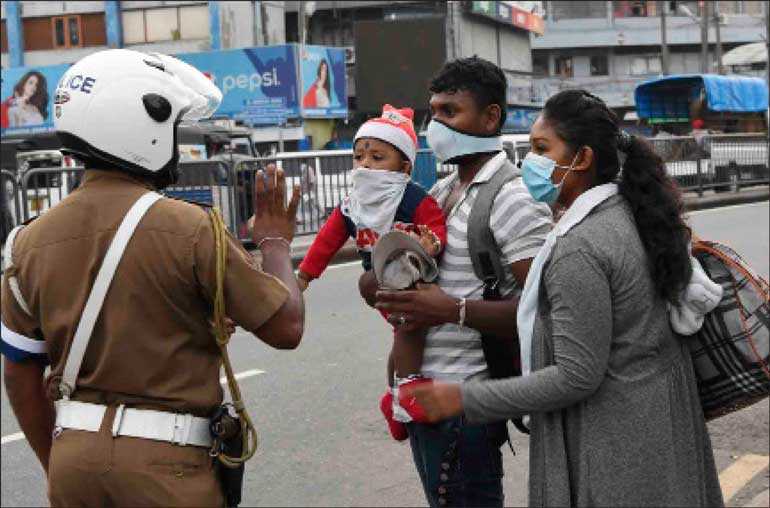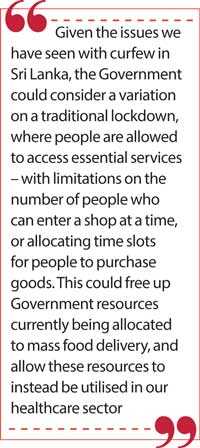Wednesday Jan 22, 2025
Wednesday Jan 22, 2025
Friday, 27 March 2020 00:00 - - {{hitsCtrl.values.hits}}

On 12 March the World Health Organisation (WHO) declared the new coronavirus, COVID-19, to be a pandemic. With cases in Sri Lanka reaching over 100, the Government of Sri Lanka has taken several measures to prevent the spread of this disease. One such measure was enforcing an island-wide  curfew.
curfew.
The risks posed by COVID-19 to the health and safety of our population is considerable, and measures to prevent the congregation of people and the spread of the disease are commendable. A lockdown may certainly be warranted, yet a highly restrictive and prolonged curfew may prove to be counterproductive.
As witnessed on Tuesday 24 March, the short window given for basic necessities such as groceries, medicine, and other supplies proved to be not only inadequate but counterproductive to the objective of imposing a curfew in the first place.
The Government lifted curfew from 6 a.m. to 12 noon, allowing people to purchase their essentials. This temporary lifting of the curfew highlighted the flaws in the solution. With limited information as to when the next curfew would be lifted, people panicked and shops were inundated.
It was not unusual to hear of someone who stood in line for six hours, practising social distancing, only to enter a supermarket that was crowded with people, and filled with empty shelves. Crowds were so great that the fear is that the number of infections in the country will now rise in the weeks to come.
Limited information exacerbating the problem
Limited information on the Government’s next steps is making the problem worse. The inherent problem with a curfew is that it cannot be imposed indefinitely. People need to have access to essentials – their food and their medicine. The curfew itself was imposed with almost no prior warning, which meant that the population panicked, hitting the shops and buying groceries that far exceeded their immediate requirement.
While this hoarding of goods has been publicly criticised, one can understand the fear that drives this behaviour. Planning the shopping of an entire country, or even one province is not an easy task – and right now people do not know when curfew will be lifted next. As of Wednesday (25 March), curfew in Colombo, Gampaha, Kalutara and Jaffna has been imposed indefinitely – there is no wonder that there was panic buying.
The Government’s solution to this issue is to allow delivery services to run, while also organising a Government-led distribution system of essentials to all families in these areas. The Presidential Task Force will coordinate this effort, mobilising Grama Niladari, Divisional Secretariat, Agricultural officers and Samurdhi officers. The motivation behind this is commendable. The question that remains is whether this will be feasible, and whether this is where the Government should be dedicating limited resources.
Is there a more effective alternative?
The Government has reassured the public, stating that there are no food shortages in the country. Empty shelves in the super markets are simply a result of panic buying, and this appears to be true. A model that has been deployed in other countries with some success is the implementation of a lock down and not a curfew. 
Under a lockdown, essential services such as banks, grocery stores, supermarkets, convenience stores, pharmacies and food delivery services remain open. People are allowed out of their homes to purchase groceries, etc., with strict guidelines on social distancing being enforced.
The Government has already taken steps in this direction, with pharmacies and commercial banks remaining open, and delivery services allowed to run. The next step would be to include grocery stores and supermarkets under the category of essential services.
Looking at the example of South Korea, a success story in the handling of COVID-19, the South Korean Government did not enter a complete lockdown. The Government instead allowed limited movement of people, but rapidly expanded their testing capacity, which helped drop rates of infection. There is the concern that as Sri Lanka’s testing capabilities are not comparable to that of South Korea, we may not be able to replicate their model with an equal degree of success.
There are other models that we can consider in this case. In America, stores have allocated separate hours for the elderly to shop during, in order to limit exposure for this vulnerable group of the population. In New Zealand, where a little over 200 cases have been reported, the country has entered lockdown, allowing only essential services to run.
Given the issues we have seen with curfew in Sri Lanka, the Government could consider a variation on a traditional lockdown, where people are allowed to access essential services – with limitations on the number of people who can enter a shop at a time, or allocating time slots for people to purchase goods. This could free up Government resources currently being allocated to mass food delivery, and allow these resources to instead be utilised in our healthcare sector.
(Aneetha Warusavitarana is the Research Manager at the Advocata Institute and can be contacted at [email protected] or @AneethaW on Twitter. Learn more about Advocata’s work at www.advocata.org. The opinions expressed are the author’s own views. They may not necessarily reflect the views of the Advocata Institute, or anyone affiliated with the institute.)